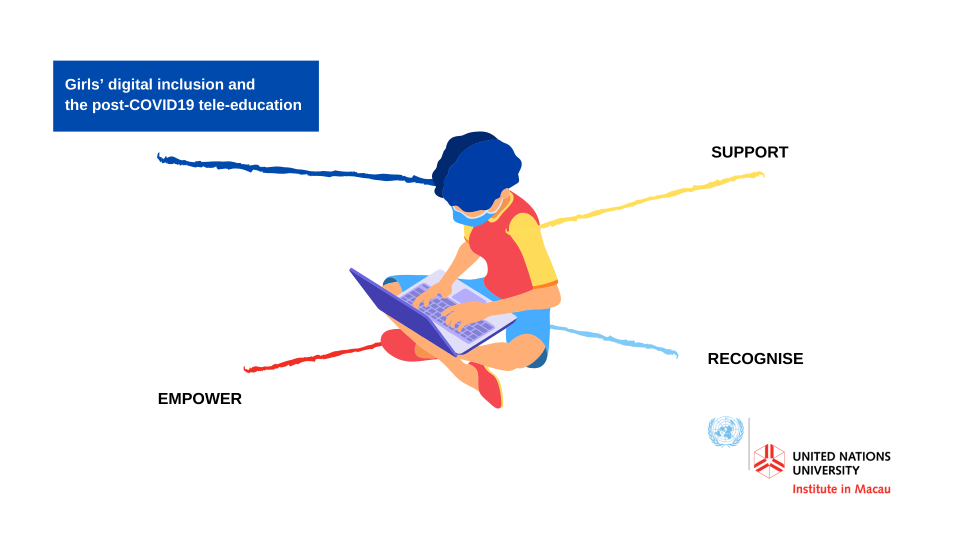The COVID-19 pandemic has dramatically changed the global educational landscape. Worldwide, 763 million girls have been out of school because of the pandemic (UNESCO, 2020). In many parts of the world, educators had to abandon their traditional classroom environments and re-configure their pedagogies in the virtual realm. This is where tele-education has proved invaluable. However, the recent accelerated expansion of the tele-education sector has exacerbated social and digital inequalities among some of the most marginalised students - many of whom are girls.
We previously talked about the devastating social and economic consequences for women and girls’ lives. It is clear that this sudden shift towards remote learning combined with the gender digital divide has had a negative impact on girls' everyday lives and their futures. As tele-education is predicted to become a core building block of post-COVID-19 education, it is important to ask: how can we ensure that any future interventions take into account the challenges associated with the gender digital divide?
In June, we explored this question as part of a seminar on tele-education, organised by the eWorldwide Group and the Institute of Electrical and Electronics Engineers Standards Association (IEEE-SA). In line with the UN's Secretary-General view, we believe that women and girls need to be at the centre of efforts to re-imagine and re-design post-COVID-19 education. Our considerations for the future of gender-sensitive digital education can be described as: recognise, empower and support.

Recognise
A critical examination of girls' diverse learning needs should be central to any future tele-education programmes. Gender-sensitive learning environments and content, should contextualise and address any existing gender stereotypes (e.g. male domination in the tech-industry, gender stereotyping). In simple terms, girls need to be able to see female role-models in their educational materials. It is also important to recognise that girls face significantly more challenges than boys when accessing technology. For post-COVID-19 digital education efforts to be truly gender-inclusive, connectivity, as well as safe and informed access to digital devices, need to be also prioritised.
Support
Support networks play a key role in girls’ lives, both in the context of education and their digital inclusion. To ensure a safe return to education post-COVID-19, girls need appropriate guidance and protection, both online and offline. Tele-education creators should consider the risks (e.g. online bullying, sexual harassment) girls experience online and possible safeguarding mechanisms. However, while technology-based solutions might offer some solutions, it is also essential to consider the role of the local community, educators, parents and guardians - all of whom play a critical role in all children’s education. Tele-education learning experiences should not only be viewed as an individual process but a collective and networked experience (e.g. guardians helping children with homework).
Empower
Technologies - and therefore tele-education solutions - are not power neutral. Any technological process can both empower and disempower girls. In recent years, digitalisation and datafication of education have led to the emergence of issues in terms of students’ surveillance, privacy, freedom of expression and choice. To strive towards girls' meaningful empowerment through tele-education, post-COVID-19 solutions should be grounded in the human-rights approach and frame learners as active digital citizens - not digital consumers. To achieve this, tele-educators might consider extending their 4A’s efforts (access, affordability, availability and awareness) by focusing on girls' critical abilities and agency. Alongside the implementation of any tele-education systems, all students should be provided with access to critical digital and data literacy education. Both critical understanding of the socio-technical power-dynamics (e.g. how algorithms might influence our everyday decisions) and their impact on society are particularly important for girls' meaningful digital participation. Tele-educators should, therefore, view girls as informed and proactive agents of future social and technological changes, whose roles are central to bridging the gender digital divide.
Suggested citation: Alicja Pawluczuk., "Recognise, Support and Empower: Girls’ Digital Inclusion and the Post-COVID-19 Tele-education," UNU Macau (blog), 2020-06-24, https://unu.edu/macau/blog-post/recognise-support-and-empower-girls-digital-inclusion-and-post-covid-19-tele.




